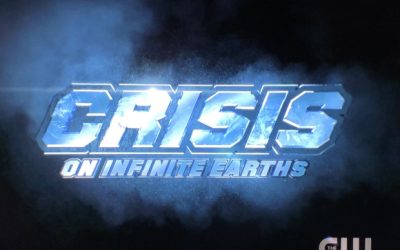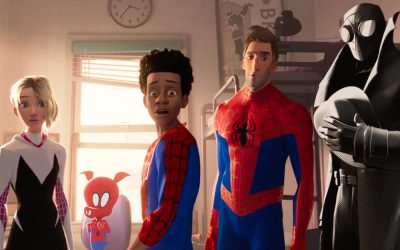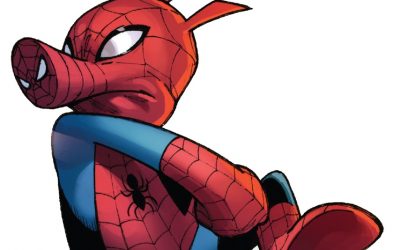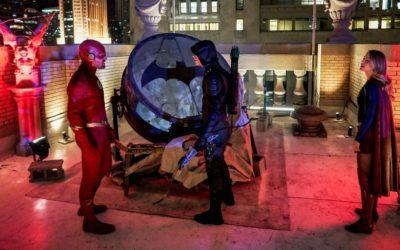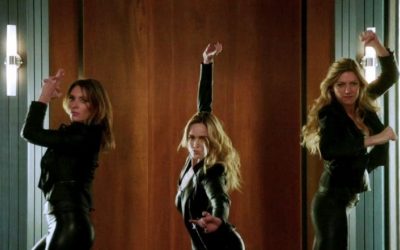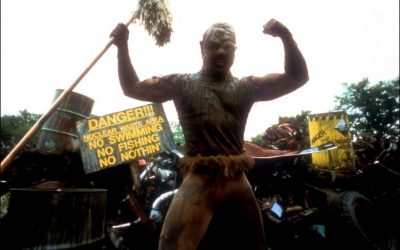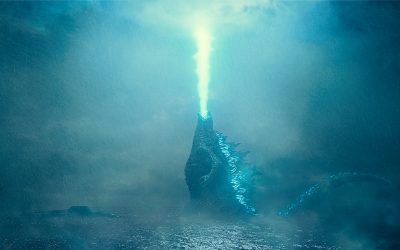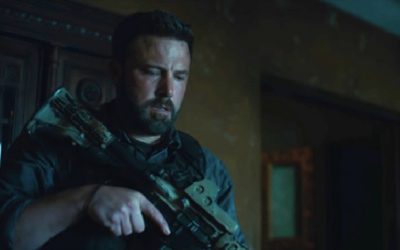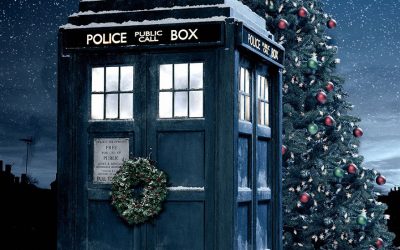
Crisis On Infinite Earths confirmed as 2019 Arrowverse crossover
Mike Cecchini
Dec 12, 2018
The 2019 Arrowverse crossover has been confirmed as none other than DC Comics classic, Crisis On Infinite Earths.
This article contains Elseworlds spoilers.
Well, Elseworlds sure was …
Spider-Man: Into The Spider-Verse: who are the characters?
James Hunt
Dec 13, 2018
Everything you need to know about the Spider-Men, Spider-Women and, er, Spider-Pigs of the Spider-Verse
This article contains spoilers for Spider-Man: Into The Spider-Verse See rela…
Everything you need to know about Spider-Man Into The Spider-Verse’s Spider-Ham
James Hunt
Dec 12, 2018
A pig with all the powers of Spider-Man, that’s obvious, but here’s everything else you need to know about Spider-Ham…
Of all the Spider-Man variants seen in Spider-Man: Into The Spider-…
Elseworlds finally explains Arrowverse Batman status
It has taken seven seasons of DC TV, but Elseworlds finally explained what’s up with the Arrowverse Batman situation.
This article consists of nothing but Elseworlds spoilers.
While we still haven’t seen Bruce Wayne show up on any Arrowverse show, after the events of ‘Elseworlds Part 2,’ the Arrow chapter of this year’s crossover event, we’re closer than we’ve ever been. The middle hour of Elseworlds introduced Bruce Wayne’s cousin, Kate Kane, as well as her Batwoman alter ego, in an episode that took place in Gotham City. Needless to say, there were plenty of Batman references to be had.
And while we broke down all of the Batman references and Easter eggs in Elseworlds over in another article, there was far more important stuff happening here. Anyone can drop a bunch of visual cues and pepper villain names throughout Arkham Asylum. After all, the DC TV shows have been packing their shows to the rafters with DC Comics references since at least the second season of Arrow. But ‘Elseworlds Part 2’ actually got work done fleshing out the scope and history of the DC Universe, all while getting to the root of how certain elements of its history can exist without being talked about all the time.
First, and most importantly, Batwoman exists in the ‘main’ Arrowverse Earth, not on Supergirl‘s Earth 38 (which would explain why Kara has heard of Batman but apparently nobody else has) or another corner of the DC Multiverse (ala Black Lightning). And while we’ve had Bruce Wayne’s name mentioned exactly once on an episode of Arrow, there has never been any indication that there is a Batman on this Earth. ‘Elseworlds Part 2’ explained it all.
For one thing, it turns out that the general perception of Batman outside of Gotham City is that he’s an urban legend. Specifically, as Oliver Queen puts it, one “concocted by the Gotham City Police to keep criminals scared.” It’s kind of funny that Ollie, in his endless cynicism, is convinced that Batman doesn’t exist, while Barry believes. It’s like the older brother trying to convince the younger brother that Santa Claus isn’t real.
But even then, you’d think that with all the other vigilante and metahuman activity that surrounds Gotham City, we’d have heard some mention of him before. Well…maybe not. The Arrowverse Batman has been missing in action for at least three years, and that Bruce Wayne vanished some time after that. Based on that timeline, it’s possible that Batman’s career was over or winding down by the time the Arrowverse got into full swing. It certainly helps explain why Oliver believes that he’s “the first vigilante,” itself a kind of meta reference to his standing as the superhero that kicked off this particular DC TV universe. But even with Batman’s existence, that doesn’t mean the Dark Knight was the first, either. Legends Of Tomorrow has established that there was a Justice Society of America, and while they were more traditional superheroes than vigilantes, we probably had a Wesley Dodds Sandman kicking some ass in the alleys of an Arrowverse city in the late ’30s at some point. Ah, but I digress…any excuse to talk about the JSA is a good one.
Anyway…
In Batman’s absence, Gotham City has started to fall apart (even by Gotham standards). After an unfortunate incident on the street, Oliver tells Barry and Kara, “this is why nobody talks about Gotham City,” a fun nod to the show’s conspicuous absence from most of the Arrowverse’s DC geographic namedrops. Between this, and the state of Wayne Enterprises, which Kate Kane says fell apart after the board of directors undertook “a bunch of aggressive get rich quick deals.” The picture painted for the Gotham City we’ll get to explore during next year’s Batwoman TV series is fairly bleak, full of just enough recognisable Batman mythology to keep fans wondering what will be lurking around the next corner, but different enough from what we’ve seen in other screen incarnations of the Dark Knight to feel fresh and interesting.
And if you want Batman villains, well, Arkham Asylum is still up and running just fine, and we see occupied cells for the Penguin, the Riddler, Poison Ivy, Clayface, and others. Notably absent from the Arkham Asylum party? The Joker and Harley Quinn. Could it have been a final confrontation with Joker that finally got the Arrowverse Batman to hang up his cowl? As for Harley, we’ve known for some time that she’s in the custody of ARGUS, waiting to run Suicide Squad missions…that we’ll sadly never get to see.
And just as Supergirl teased fans with Superman and Clark Kent from her very first episode but made us wait until her second season to properly introduce the Man of Steel, the door is now finally open to see Batman in live action on the small screen again. Don’t be surprised if the Batwoman TV series takes the Supergirl approach and makes us wait until (at least) season two, though, if not longer. Hell, ‘The Return of Bruce Wayne’ could probably fuel a December crossover all its own.
Legends Of Tomorrow season 4 episode 8 review: a rare mistep
In Legends Of To-Meow-Meow, Legends Of Tomorrow tries to do too much and ends up with too little. Spoilers for the midseason finale…
This review contains spoilers.
4.8 Legends Of To-Meow-Meow
It sucks that Legends Of Tomorrow had their first real miss as their midseason finale. However, it says something about Legends that their worst episode of the season is still sooooooo entertaining.
Legends Of To-Meow-Meow picks up where Hell No, Dolly left off – after Constantine changed time to protect Dez from the most dangerous force in the DC television multiverse (John’s own self interest). The new shapeshifter, Charlie, has her powers back, but also Zari is a cat.
We spend the rest of the episode in escalatingly ridiculous situations with Constantine and Charlie trying to change anything they could to keep Dez alive and Charlie’s powers working. First, Nate, Ray, Mick and Garima are the “Custodians of the Chronology,” an A-Team knockoff executing magical anomalies as they find them. The change that John and Charlie made keeps John from joining the team, and led to Sara getting gored by the unicorn in episode one and sent the boys over the deep end. It also turned Ava into an Indigo Girls-listening goth (which makes no sense – the Indigo Girls are extremely not goth). So Goth Ava teams up with Mona, Charlie, John and Cat Zari to set things right.
The jumpship goes back to Woodstock and zaps the unicorn before it can gore anyone, but that just leads to the fairy godmother in Salem killing all the guys, and Ava, Sara and an upgraded Gideon going all Charlie’s Angels on the timestream as the Sirens of Space-Time.
Here’s the thing. Last week, we talked about how the writers know their characters inside out, and the week before that it was about how they put character to work advancing the plot rather than making them change to fit the plot. That… didn’t really happen here. Instead, we got a bunch of gimmicks thrown at the screen in the hopes that volume would overcome character gaps. As great as almost every single gimmick was, though, they failed to include anything that had a similar emotional impact to what came last week with our flash of sympathy for John.
Here, every time someone on the team dies, everyone else turns into a sociopath. Ray and Nate are arguing over who gets more kills, and Ava and Sara are straight up bullies. So as amazing as puppet Legends are, or as sweet and adorable as Cat Zari is, or as Looney Tunesian the continuous memorials in the Time Bureau are, it doesn’t work because of how dense John and Charlie are and how over the top everyone’s response to death is. This is a crew of serial mopers. Ray and Nate don’t turn into cold blooded killers when Sara dies, they cry and drink together.
Constantine eventually catches the hint and crafts an elaborate plan to go back to New Orleans, create a third walking Constantine in the same time period, and keep his relationship with Dez alive so he can stop Dez from being alive as (presumably) a part of a deal with Neron. It works and resets the timeline to what it’s supposed to be, and now we have no more Legends Of Tomorrow until April. Presumably there we’ll find out more about why Dez is now probably Neron and he’s golfing with Hank Haywood.
Read Jim’s review of the previous episode, Hell No, Dolly, here.
Toxic Avenger franchise lands at Legendary
Mike Cecchini
Dec 11, 2018
It looks like we might be headed for a Toxic Avenger reboot.
Somehow, against all odds, nobody has managed to reboot The Toxic Avenger yet. Oh, there have been attempts. In 2013, Arno…
New Godzilla II: King Of The Monsters trailer roars into view
The beasts get even bigger in the next instalment of Legendary Pictures’ Monsterverse
Super-sized beasts go to war in the latest in Legendary Pictures’ expanded monster universe, which began with Gareth Edwards‘ Godzilla back in 2014, continued with Kong: Skull Island in 2017 and is about to get even more mega when Godzilla II: King Of The Monsters lands next Spring.
Directed by Michael Dougherty who made Krampus and the rather marvellous anthology horror Trick ‘R Treat, the movie sees Godz’ go to war with other classic Toho titans Mothra, Rodan, and three-headed King Ghidorah. If you’re a human in the Monsterverse it sounds like a sturdy hat and a pair of noise-cancelling earphones could be in order.
In the meantime, you can watch the latest trailer below.
Cowering beneath the madness is Sally Hawkins and Ken Watanabe reprising their roles from Godzilla 2014 as scientists with crypto-zoological agency Monarch. They’ll be joined by Vera Farmiga from The Conjuring, Millie Bobby Brown from Stranger Things and Kyle Chandler, who’s well-used to dealing with behemoths after starring in Super 8.
The first trailer for Godzilla II: King Of The Monsters arrived at San Diego comic-con – it looked great and went down a storm, with the emphasis very much on scale, so we’re super excited to see what this movie has to offer. Especially since the follow up is set to be Godzilla Vs. Kong in 2020 (so, um, spoiler alert, we reckon he’ll probably make it out the other side one way or another).
Godzilla II: King Of The Monsters opens in the UK on 31 May 2019.
James Bond 25 reportedly trying to cast Rami Malek as villain
Kirsten Howard
Dec 10, 2018
Tricky.
Could Rami Malek be about to follow in the footsteps of Christoph Waltz, Mads Mikkelsen and Javier Bardem? The answer is “hmm.” See related
Clique serie…
Triple Frontier trailer: first look at Netflix’s film flex
Ben Affleck, Oscar Isaac, Charlie Hunnam, Garrett Hedlund and Pedro Pascal star in a flick that’s been a long time coming.
This one has gone through the wringer.
Hurt Locker scribe Mark Boal wrote Triple Frontier years ago for Katheryn Bigelow to helm, but it never fell into place. Then, the likes of Tom Hanks, Will Smith, Johnny Depp, Channing Tatum, and Tom Hardy all spent time circling the film, before incoming director J.C. Chandor (A Most Violent Year) managed to lock down Ben Affleck, only for him to have to delay his involvement for a trip back to rehab.
Out and ready to work again, but having lost brother Casey and Moonlight‘s Mahershala Ali from his list of co-stars, the quest was on to find “the movie that refused to die” a new cast to support Phantoms bomb Affleck, as the project got a helpful leg up from Netflix.
Chandor somehow managed to snag Oscar Isaac, Charlie Hunnam, Garrett Hedlund and Pedro Pascal between their hectic schedules, and Triple Frontier is now heading to the streaming giant in March, 2019.
In the upcoming flick, “a group of former Special Forces operatives reunite to plan a heist in a sparsely populated multi-border zone of South America. For the first time in their prestigious careers these unsung heroes undertake this dangerous mission for self instead of country. But when events take an unexpected turn and threaten to spiral out of control, their skills, their loyalties and their morals are pushed to a breaking point in an epic battle for survival.”
You can see the first trailer below…
No specific release day has yet been set for March, but we’ll update you when we get one.
Doctor Who: revisiting Russell T. Davies’ Christmas specials
With Doctor Who’s festive episode moving to New Year’s Day, we look back at the show’s previous Christmas specials…
2018 marks the end of a modern festive tradition, as Doctor Who swaps its Christmas special for a New Year’s Day edition instead. Up until now, we’ve only had one Doctor Who story that dealt with the New Year and that was the 1996 TV movie, which premiered on BBC One in May!
On the other hand, there’s an entire season’s worth of Christmas specials to watch and while it’s ridiculous to suggest that the show has simply run out of festive ideas, the change might be friendlier for binge-watching in, say, July, when you don’t have an adventure with killer Santas or wintry vistas every 13 episodes or so.
Even if some of us will miss having new Who to watch on Christmas Day, the new series has given us plenty of specials to revisit. Barring William Hartnell’s iconic, fourth-wall-breaking moment from the end of the accidental Christmas episode The Feast Of Steven, the founder of the feast is Russell T. Davies, who set the tone for these specials as he did for so many others.
From the very first special that was commissioned, they’re never throwaway bits of festive frippery. It’s partly due to most of them resolving direct cliffhangers from the preceding series, but his specials often feature significant story landmarks while still welcoming everyone from the odd casual viewer to the most devoted fans.
In this first part of our look back at Doctor Who’s Christmas specials to date, we’ll revisit each of Davies’ flagship episodes (and a few other seasonal highlights) to see what each one brings to the table, what you should watch out for, and which one you might want to pick to watch on iPlayer on the 25th, instead of Michael McIntyre.
Honourable mention: The Unquiet Dead (2005)
Timey-wimey stuff being what it is, we start with an episode that didn’t actually air on the 25th of December. The first proper Christmas special was commissioned after the first series became a huge hit, which means that Christopher Eccleston never got to star in a festive edition of the revived programme. However, his third trip back in time took him to Cardiff in 1869 for a brush with Charles Dickens and the ghostly Gelth.
Perhaps the best of Mark Gatiss’ new series’ scripts, The Unquiet Dead is a nice bit of phantasmagoria, introducing a spookier and darker element into the series at a crucial early stage in its revival. While famous characters are more central in the later “celebrity historical” episodes, Simon Callow’s Dickens is more of an enjoyable tagalong in what turns out to be the genesis of Torchwood, introducing Eve Myles and a rift in time and space under the Welsh capital.
All ties to later episodes aside, it’s a suitably modern version of a familiar genre from the classic series. As part of the regular run, it follows that this one can be watched at any time of year, but if you like your Christmas specials a little more gothic and violent than others, give this one another look while you’re scoffing mince pies.
Better watch out: The Ninth Doctor is something of a Dickens hipster, citing The Signal-Man as the author’s best Christmas ghost story rather than A Christmas Carol. First published in 1866, the short story was previously adapted for the screen as part of the BBC’s A Ghost Story For Christmas, a series that was also revived in 2005 and continues this Christmas Eve with Gatiss’ The Dead Room.
The Christmas Invasion (2005)
Doctor Who’s first-ever specially produced Christmas special had a lot on its plate. More than just being a festive outing, it also has to introduce David Tennant’s Doctor, as well as the implications of regeneration to an audience that only just got to know Eccleston as the Time Lord. Some more familiar faces ease the transition and Rose’s prominence in the first series really pays off, as she effectively takes the lead while the Doctor sleeps off his time vortex hangover.
What’s impressive is that there’s no sense of it being any lighter than any other Doctor Who episode, especially when the Sycorax’s M.O. is to drive a third of the world’s population to perch themselves on the roofs of tall buildings, apparently ready to kill themselves on command. Despite the jeopardy leading up to the ending, the dark-edged jollity comes from Davies’ typically marvellous script (“Have we heard from the royal family? Oh, they’re on the roof”) rather than the setting.
Right up to Harriet Jones’ Belgrano-esque folly, it’s a proper sci-fi thriller, designed for primetime BBC One on the biggest day, and it’s a brilliant end to Doctor Who’s first year back on the air. It even makes time to start a nice Christmas tradition of Murray Gold writing original songs for the specials, as Tim Phillips warbles Song For Ten over the Doctor’s Christmas evening with the Tylers (which is clearly where he got his “best Christmas Walford’s ever had” reference in The Impossible Planet, by the way).
Better watch out: The highlight of the 2016 anthology book The 12 Doctors Of Christmas is Jacqueline Rayner’s The Christmas Inversion, in which the Third Doctor picks up Harriet Jones’ Christmas Day address and mistakes it for a distress call from the future. Landing on the Powell Estate in 2005, he’s flummoxed when Jackie Tyler barges in with tea and sandwiches. It’s exactly as brilliant as it sounds.
Attack Of The Graske (2005)
The Tenth Doctor’s second episode was released the same night as his first. Written by Gareth Roberts, this 15-minute “interactive episode” debuted on the BBC’s red button service right after The Christmas Invasion was broadcast. Bringing the viewer into the Doctor’s latest pursuit, the story asks you to help track down a body-snatcher who’s meddling in Christmases past, present, and (if they get their way) yet to come.
Played by Jimmy Vee, the Graske have some traits in common with the Zygons, such as replacing other people with duplicates and keeping the real person alive in stasis. After tracking the Graske back to their home planet through a series of puzzles, the choose-your-own-adventure story leaves it up to the viewer to decide how the story ends.
For those who played this on Christmas night, Attack Of The Graske cements Tennant’s charismatic portrayal of the Doctor. The game was previously available to play on the BBC website but seems to have been taken down (possibly because of a certain disgraced recording artist’s Another Rock And Roll Christmas featuring in the happy ending?). If you don’t mind missing out on the interactive element, there are plenty of playthroughs available to watch online.
Better watch out: Roberts brought his monster back in The Sarah Jane Adventures, where a Graske called Krislok serves as the unwilling henchman of the series’ Big Bad, the Trickster. You can also spot a Graske among the assorted alien punters of the bar that Captain Jack Harkness visits in The End Of Time Part 2, which is the only other New Year’s Day special.
The Runaway Bride (2006)
The Doctor first meets Donna Noble as a cliffhanger at the end of Doomsday. Popping into the TARDIS on her wedding day, she arrives at just the right time to stop him getting too mopey about Rose and also, as we later learned in Turn Left, to prevent him from going too far in foiling the monster of the week.
Just like The Christmas Invasion, The Runaway Bride follows the departure of one of the leads but given the emphasis on the companion as a co-lead, it’s a bigger deal this time. Davies handles it deftly, throwing the Doctor into a new action-packed adventure. Happily, the Tracy and Hepburn-like chemistry between Tennant and Catherine Tate is obvious from the beginning and it’s no surprise that Donna was eventually brought back as a full-time companion.
If you didn’t know better, you’d think it was always planned this way. Donna arrives as fully formed as any of RTD’s characters and brings a screwball comedy element that makes this a lighter story than the Sycorax’s shenanigans. All that and some more robot Santas, a fearsomely made-up Sarah Parish playing a giant spider, and the new series’ first ever mention of Gallifrey.
Better watch out: This year’s original song by Murray Gold features during Donna’s wedding reception, as the Doctor is reminded of Rose while watching Donna dance with Lance. Neil Hannon sings the Al Wilson-alike Love Don’t Roam, which featured on the new series’ first soundtrack release. Fans campaigned to get the song into the UK single download chart after the rules changed in 2007, but it didn’t crack the top 40.
Voyage Of The Damned (2007)
In every sense, Voyage Of The Damned is the Doctor Who Christmas Day blockbuster. From its execution to its audience reception, this extended jaunt with Kylie Minogue on the Starship Titanic is constantly ambitious and adventurous. It’s RTD taking big swings and casting big stars, at a point in time where the BBC’s big terrestrial film premiere was more likely to be a Pixar animation than an Indiana Jones.
In terms of film premieres from times gone by, Davies’ objective here is to make The Poseidon Adventure in space. He clearly has more of a sense of the disaster movie genre than the Doctor, whose repeated promises that no more of the obviously doomed ensemble of alien tourists are going to die become slightly hilarious. All in all, it’s a big part of its charm.
Even if it’s rarely vaunted among the very best seasonal offerings, it’s an absolute blast and there’s a bit more to it than the Hollywood gloss it so successfully mimics. As in the Irwin Allen movies that inspired it, there’d be little point in the spectacle if we weren’t invested in the characters. And frankly, Doctor Who wouldn’t be Doctor Who if at least one of those characters wasn’t a conker-headed cyborg.
Better watch out: The mighty Bernard Cribbins makes his debut as Wilfred Mott in this story. Originally intended as a one-off character, Cribbins had a lovely time and was brought back as Donna’s grandad in Partners In Crime, after the late Howard Attfield retired from his role as Donna’s dad due to illness. A couple of Christmases later, this turns out to be the most important cameo in the universe…
The Next Doctor (2008)
After deciding against a similarly high-concept idea like “Cheryl Cole on the Hindenburg” as a follow-up, Doctor Who’s greatest showman lined up a different sort of attraction. With Tennant having announced his departure live at November’s National Television Awards, the announcement that David Morrissey would star in an episode called The Next Doctor had the desired effect in terms of publicity.
It has some of the blockbuster trappings of the previous instalment, but it’s a darker story than it’s often given credit for. Aside from foreshadowing the specials arc by confronting Tennant’s incarnation with a possible future Doctor, the eventual reveal of Morrissey’s Jackson Lake and his tragic backstory is weighty stuff for Christmas Day.
Mind you, it’s wrapped up in one of the more out-there plots involving the Cybermen and their off-brand Cybermats, the doggo-like shades. It wraps up with a giant Cyber-King stomping all over 19th century London, a detail that was explained away a year and a half later by the incoming showrunner’s cracks in time.
Better watch out: Journey’s End originally ended with a cliffhanger featuring the Cybermen inside the TARDIS, prompting the then-traditional “What? WHAT? … what?” ending. This scene was shot and features in the extras of the Series 4 boxset as a deleted scene. Davies was persuaded to cut the scene by Doctor Who Magazine writer Benjamin Cook, creating some distance between the downer ending of the finale and this special.
The End Of Time (2009-2010)
RTD’s final Christmas special is the one that has had the most influence on the format since. The Tenth Doctor was kind of born on Christmas Day, and he would kind of die around the same time. Notably, Davies pushed for a two-part finale to the specials year, so that they wouldn’t have to do a regeneration episode on Christmas Day. Featuring Part 1 and Part 2 in their titles for the first time since the classic era, The End Of Time two-parter was an epic event.
Set on and around the big day, the first part is festively foreboding, as Cribbins salutes the Queen’s speech, John Simm’s Master tucks into homeless people like they’re roast turkey, and Timothy Dalton issues silky-voiced, spittle-flecked narration about Christmas Day being the final day of planet Earth. If the casual audience wasn’t already a bit lost, then it ends with the ferociously surreal cliffhanger of everyone except a select few people turning into duplicates of the Master.
The Tenth Doctor’s era actually came on New Year’s Day, which must have been nice for parents with hangovers. After a showdown with the Time Lords that closes the entire Time War arc (for the moment), the climax brings the fatal four knocks and then a victory lap for both Davies and Tennant. There are tears, but because it’s Christmas, there are more conker-heads, in the form of the visiting Vinvocci.
Taking in the entire regular cast since 2005, it’s the final bow on a bombastic finale. Just to bring Tennant’s Christmas specials full circle, Gold even sneaks in an instrumental reprise of Song For Ten, shortly before Matt Smith’s Doctor explodes onto the screen.
Better watch out: Echoing the blanket promotion of Wallace & Gromit: A Matter Of Loaf & Death the previous Christmas, The End Of Time’s status as BBC One’s jewel in the crown was affirmed by Tennant’s place in the channel’s Christmas ident. Coupled with Tennant’s press tour, panel show bookings, and appearances in other comedies and dramas, it felt like he, if not the Doctor, was absolutely everywhere. But more importantly, is the reindeer thing canon?
Come back next week for our look at the rest of Doctor Who’s festive episodes.

